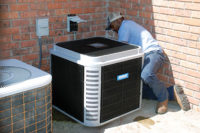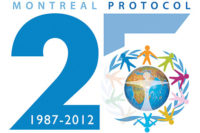While much interest is being directed to so-called “natural” refrigerants such as CO2, HCs, and ammonia, attention is also being paid to HCFCs and HFCs, as they remain the dominant refrigerants in HVACR systems in North America. A recent wave of published reports focuses on new ways to monitor HCFCs during their phaseout period, HFCs in terms of their long-term potential, and how Canada is dealing with the disposal of unwanted refrigerants.
HCFCs
According to a posting on May 30 at the online publication R744.com, “The United Nations Environment Programme is working on a HCFC Knowledge Portal that aims to become an effective online tool to actively engage with policy and industry stakeholders in the HCFC phaseout process.”
The report went on to note that the current HCFC Help Center is being overhauled to better keep people advised of changes which earlier this year included a proposal from the United States Environmental Protection Agency (EPA) to speed up the phaseout of HCFCs in the United States.
“The future interactive platform aims to exchange knowledge between countries with acquired knowledge on the HCFC phaseout process to countries still facing stronger challenges. It will be open to all involved stakeholders, serving as a catalyst for best practice,” was the comment from R744.com.
In this case, the United States might be considered at the midpoint in terms of challenges as Europe and Asia have had faster phaseouts in the use of HCFCs, while so-called “developing” countries like China and India are at a slower pace.
The new portal is being created to allow Q&A and discussion forums as well as Twitter and Facebook options.
Part of the process to ready the portal is a survey among those with a vested interest in the phaseout process. “The survey — available in English, French, and Spanish — will enquire about priorities of different countries and world regions in the HCFC phaseout process, identify networks and communication needs, and outline general use patterns of Internet tools.” The report said it will take around 10-15 minutes to reply to 19 questions in the following fields:
• Policy, HCFC phaseout and alternatives;
• Information Sources, Networks & Communication Needs;
• HCFC Knowledge Portal;
• IT Use & Social Media;
The new portal is expected to be launched in the fall.
HFCs
In a report published, the Environmental Investigation Agency (EIA) “has filed a formal petition asking the EPA to require an end for nearly all uses of the most commonly used fluorocarbon in the U.S., HFC-134a.”
The EIA is a London-based environmental activist organization. Its petition was in addition to petitions filed by the EIA, the National Resources Defense Council, and the Institute for Governance and Sustainable Development specifically targeting HFC-134a in mobile air conditioning systems. So the latest EIA petition goes beyond mobile air conditioning to challenge R-134a use in stationary systems such as are common in the HVACR sector.
The report said that since being initially approved in the 1990s as a replacement for ozone depleting substances (ODS), “HFC-134a use has grown to include many other applications besides auto and truck a/c systems, and is now the most abundant HFC used in the U.S. Domestic refrigerators, foam insulation panels, aerosols, tire inflators and a host of ‘frivolous uses’ including children’s toys, keyboard cleaners, and air horns that all commonly use HFC-134a despite the wide availability of inexpensive, equally effective, and climate-safe alternatives.”
The report said R-134a makes up “approximately half of all HFC use in the U.S.”
EIA is recommending that HC refrigerant alternatives be considered. “Although hydrocarbons received EPA approval for use in the U.S. in January, no timetable has yet been established to require their use in domestic refrigerators and freezers or retail stand-alone coolers and freezers,” EIA said.
“Technology has advanced to the extent that HFCs are rapidly becoming obsolete,” said Mark W. Roberts, senior legal counsel for EIA. He added, “The increasing availability of low-impact and equally or even superior energy-efficient alternatives requires action to phase out the use of compounds that needlessly contribute to climate change.”
“The United States has demonstrated exemplary leadership and vision in its efforts to control ozone depleting substances and HFCs on a global level,” according to Samuel LaBudde, EIA’s senior atmospheric campaigner. “U.S. action to phaseout HFCs at home is appropriate if not overdue, and will only reinforce the prospect for eliminating HFCs worldwide.”
Canadian Perspective
Activities regarding f-gases are also continuing in Canada. Refrigerant Management Canada (RMC) announced that it has successfully verified and registered 170,000 ODS-derived registered emission reductions (RERs) on the Canadian Standards Associations (CSA) Reductions Registry. This is the first successful verification of an ODS destruction project in Canada, it said.
A statement from RMC said that as a “not-for-profit corporation, RMC is the first and only industry-led environmental care program committed to the responsible disposal of surplus ozone depleting refrigerants in Canada. Since 2000, RMC has diverted the release of over 2.7 million kilograms of refrigerant from the atmosphere.
“The initial verification of this achievement involved the successful quantification, registration and serialization of the ODS sourced by RMC from across Canada and destroyed at the Swan Hills Treatment Centre in Swan Hills, Alberta,” RMC said in a statement.
“We are proud to have officially quantified and verified the significant greenhouse gas reductions that our heating and refrigeration partners have helped the RMC program achieve. Ensuring that these potent greenhouse gases — having some of the highest known Greenhouse Warming Potential (GWP) values — are properly recovered and destroyed is the goal of our program,” noted Warren Heeley, president of RMC.
Publication date: 8/6/2012






